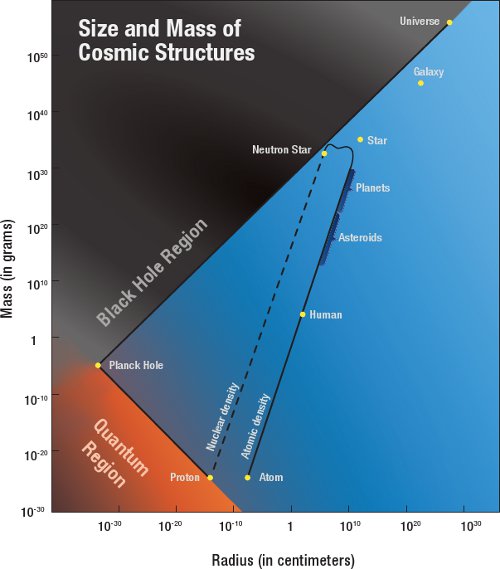
The last few centuries have taught us that the cosmos is filled with objects and structures that come in an astonishing range of sizes and masses. On one hand, we have particles such as the proton, with a size of less than one tenth of a trillionth of a centimeter (this is written as 10 in scientific notation; 1 at the 13th decimal place), and on the other, we have huge superclusters of galaxies with sizes of about a hundred trillion trillion (10) centimeters. Similarly, masses can range from about 10 grams for the electron, to about 10 grams for clusters of galaxies.
With such an incredible profusion of sizes, masses, and characteristics in general, one would not expect to find any correlations among the different objects. In particular, suppose you created a diagram with sizes marked on one axis, and mass on the other (as in Figure 1). Imagine now that you place all the known entities on this diagram. You might expect to obtain a completely random scatter of points, a bit like the stars in the night sky. Yet, when astrophysicists Bernard Carr and Martin Rees did this precise exercise in 1979, they discovered something surprising. Rather than being randomly distributed, the points tended to cluster along a fairly narrow stripe (Figure 1)!
Figure 1. Adapted with permission from B. J. Carr & M. Rees 1979, Nature, 278, 605.
When physicists encounter unanticipated patterns, their curiosity is immediately piqued. When Carr and Rees started analyzing the diagram, the first thing they noticed was that much of the clustering was simply a consequence of the fact that almost all the things we are familiar with are composed of atoms. Whether these are rocks, plants, animals, or planets and ordinary stars, atoms are the basic building blocks of matter. And while there are some small differences in the ways atoms are packed in various structures, it remains true that the density of things ranging from atoms to stars is roughly equal to the atomic density (the ratio of the mass of an atom to its volume). Consequently, Figure 1 contains a diagonal line that marks a constant atomic density, and the points corresponding to atoms, humans, asteroids, planets, and ordinary stars, all fall along this line. Parallel to this line there is another diagonal line that corresponds to the much high density of the atomic nucleus. The proton, one of the nuclear constituents, lies on this line, as do neutron stars--extremely compact stellar cores with a mass of about that of the Sun, but a radius of only about six miles. A line that runs diagonally from bottom left to upper right marks the edge of the black hole region. Objects that lie above this line, in the upper left of the diagram, are so dense that according to Einstein's theory of General Relativity no mass, light, or information can escape from them. In other words, short of some exotic quantum processes, outside observers cannot directly see objects that are so compact.
Finally, there is one more line (marking the "Quantum Region") that characterizes the quantum sub-atomic world. In quantum mechanics, rather than being point-like objects, particles (such as the electron) can behave like waves. Those waves determine the probability of finding the particles at certain positions at certain times. The line represents the uncertainty in the location of a mass set by the uncertainty principle of quantum theory.
The key message of this extraordinary figure is the fact that sizes in our universe are primarily determined by the weakness of gravity in the atomic microworld. As a result, all the structures that are dominated by gravitational effects (such as stars, galaxies, and the cosmos as a whole) have to be extremely massive. With a much stronger gravity, the universe would have been much smaller, and its lifespan much shorter. With zero gravity, on the other hand, no cosmic structures would have existed at all.